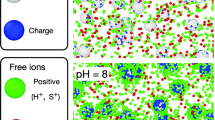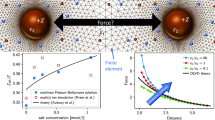Abstract
The dominant modes of charge transport in variant polar liquid-based nanoparticulate colloidal dispersions (dilute) have been theorized. Theories formulating electrical characteristics of colloids have often been found to over- or under-predict charge transport in dilute suspensions of nanoparticles in polar fluids owing to grossly different mechanistic behaviors of concentrated systems. Three major interacting modes with independent yet simultaneous existence have been proposed and found to be consistent with analyses of experimental data. Electric double layer (EDL) formation at nanoparticle–fluid interface-conjugated electrophoresis under the influence of the electric field has been determined as one important mode of charge transport. Nanoparticle polarization due to short-range field non-uniformity caused by the EDL with consequent particle motion due to inter-particle electrostatic interactions acts as another mode of transport. Coupled electro-thermal diffusion arising out of Brownian randomization in the presence of the electric field has been determined as the third dominant mode. An analytical model based on discrete interactions of the charged particle–fluid domains explains the various behavioral aspects of such dispersions, as observed and validated from detailed experimental analysis. The analysis is also predictive of the dominance and behavior of the three modes with important nanocolloidal parameters such as temperature and concentration.
Graphical Abstract








Similar content being viewed by others
References
Anoop KB, Kabelac S, Sundararajan T, Das SK (2009) Rheological and flow characteristics of nanofluids: influence of electroviscous effects and particle agglomeration. J Appl Phys 106:034907–034909
Buongiorno J, Venerus DC, Prabhat N, McKrell T, Townsend J, Christianson R, Tolmachev YV, Keblinski P, Hu L-W, Alvarado JL et al (2009) A benchmark study on the thermal conductivity of nanofluids. J Appl Phys 106:094312–094312–094312–094314
Cametti C (2010) Dielectric spectra of ionic water-in-oil microemulsions below percolation: frequency dependence behavior. Phys Rev E 81:031403
Carrique F, Arroyo F, Delgado A (2001) Electrokinetics of concentrated suspensions of spherical colloidal particles: effect of a dynamic stern layer on electrophoresis and DC conductivity. J Colloid Interface Sci 243:351–361
Chakraborty S, Padhy S (2008) Anomalous electrical conductivity of nanoscale colloidal suspensions. ACS Nano 2:2029–2036
Curtis HJ, Fricke H (1935) The electrical conductance of colloidal solutions at high frequencies. Phys Rev 48:775-775
Das SK, Putra N, Thiesen P, Roetzel W (2003) Temperature dependence of thermal conductivity enhancement for nanofluids. J Heat Transf 125:567–574
Dhar P, Ansari M, Gupta S, Siva VM, Pradeep T, Pattamatta A, Das S (2013a) Percolation network dynamicity and sheet dynamics governed viscous behavior of polydispersed graphene nanosheet suspensions. J Nanopart Res 15:1–12
Dhar P, Sen Gupta S, Chakraborty S, Pattamatta A, Das SK (2013b) The role of percolation and sheet dynamics during heat conduction in poly-dispersed graphene nanofluids. Appl Phys Lett 102:163114–163114–163114–163115
Eastman JA, Choi SUS, Li S, Yu W, Thompson LJ (2001) Anomalously increased effective thermal conductivities of ethylene glycol based nanofluids containing copper nanoparticles. Appl Phys Lett 78(6):32
Evans W, Prasher R, Fish J, Meakin P, Phelan P, Keblinski P (2008) Effect of aggregation and interfacial thermal resistance on thermal conductivity of nanocomposites and colloidal nanofluids. Int J Heat Mass Transf 51:1431–1438
Ganguly S, Sikdar S, Basu S (2009) Experimental investigation of the effective electrical conductivity of aluminum oxide nanofluids. Powder Technol 196:326–330
Goldstein RE, Halsey TC, Leibig M (1991) Thermodynamics of rough colloidal surfaces. Phys Rev Lett 66:1551–1554
Hückel E (1924) Zur theorie konzentrierterer wässeriger Lösungen starker elektrolyte. Physik Z 25:204
Khusid B, Acrivos A (1996) Effects of interparticle electric interactions on dielectrophoresis in colloidal suspensions. Phys Rev E 54:5428–5435
Kumar DH, Patel HE, Kumar VR, Sundararajan T, Pradeep T, Das SK (2004) Model for heat conduction in nanofluids. Phys Rev Lett 93:144301
Kuwabara S (1959) The forces experienced by randomly distributed parallel circular cylinders or spheres in a viscous flow at small Reynolds numbers, J Phys Soc of Japan 14–4
Last BJ, Thouless DJ (1971) Percolation theory and electrical conductivity. Phys Rev Lett 27:1719–1721
Lebovka NI, Tarafdar S, Vygornitskii NV (2006) Computer simulation of electrical conductivity of colloidal dispersions during aggregation. Phys Rev E 73:031402
Makino K, Ohshima H (2010) Electrophoretic mobility of a colloidal particle with constant surface charge density. Langmuir 26(23):18016
Matijevic E (1971) Characterization of aqueous colloids by their electrical double-layer and intrinsic surface chemical properties. Surf Colloid Sci 3
Miles JB Jr, Robertson HP (1932) The dielectric behavior of colloidal particles with an electric double-layer, physical. Review 40:583–591
Minea A, Luciu R (2012) Investigations on electrical conductivity of stabilized water based Al2O3 nanofluids. Microfluid Nanofluid 13:977–985
Mittal M, Lele PP, Kaler EW, Furst EM (2008) Polarization and interactions of colloidal particles in ac electric fields. J Chem Phys 129
Murshed SMS, Leong KC, Yang C (2008) Investigations of thermal conductivity and viscosity of nanofluids. Int J Therm Sci 47:560–568
Ohshima H, Healy TW, White LR (1982) Accurate analytic expressions for the surface charge density/surface potential relationship and double-layer potential distribution for a spherical colloidal particle. J. Colloids Interface Sci 90:17
Pak BC, Cho YI (1998) Hydrodynamic and heat transfer study of dispersed fluids with submicron metallic oxide particles. Exp Heat Transf 11:151–170
Patel HE, Das SK, Sundararajan T, Sreekumaran Nair A, George B, Pradeep T (2003) Thermal conductivities of naked and monolayer protected metal nanoparticle based nanofluids: manifestation of anomalous enhancement and chemical effects. Appl Phys Lett 83:2931–2933
Patel HE, Sundararajan T, Das SK (2010) An experimental investigation into the thermal conductivity enhancement in oxide and metallic nanofluids. J Nanopart Res 12:1015–1031
Revil A (1999) Ionic diffusivity, electrical conductivity, membrane and thermoelectric potentials in colloids and granular porous media: a unified model. J Colloid Interface Sci 212:503–522
Sarojini KG, Manoj SV, Singh PK, Pradeep T, Das SK (2013) Electrical conductivity of ceramic and metallic nanofluids. Colloids Surf A 417:39–46
Sastry NNV, Bhunia A, Sundararajan T, Das SK (2008) Predicting the effective thermal conductivity of carbon nanotube based nanofluids. Nanotechnology 19:055704
Wen D, Ding Y (2004) Experimental investigation into convective heat transfer of nanofluids at the entrance region under laminar flow conditions. Int J Heat Mass Transf 47:5181–5188
Wen D, Ding Y (2005) Effect of particle migration on heat transfer in suspensions of nanoparticles flowing through minichannels. Microfluidics Nanofluidics 1:183–189
Wong KFV, Kurma T (2008) Transport properties of alumina nanofluids. Nanotechnology 19:345702
Xuan Y, Li Q (2002) Investigation convective heat transfer and flow features of nanofluids. J Heat Transfer 125:151–155
Zhang X, Gu H, Fujii M (2007) Effective thermal conductivity and thermal diffusivity of nanofluids containing spherical and cylindrical nanoparticles. Exp Therm Fluid Sci 31:593–599
Acknowledgments
The authors would like to thank DMSRDE, Kanpur, India (a Defense Research and Development Organization (DRDO) Laboratory) for funding the research initiative. P.D would also like to thank the Ministry of Human Resource and Development (Government of India) for the doctoral research scholarship.
Author information
Authors and Affiliations
Corresponding author
Rights and permissions
About this article
Cite this article
Dhar, P., Pattamatta, A. & Das, S.K. Trimodal charge transport in polar liquid-based dilute nanoparticulate colloidal dispersions. J Nanopart Res 16, 2644 (2014). https://doi.org/10.1007/s11051-014-2644-3
Received:
Accepted:
Published:
DOI: https://doi.org/10.1007/s11051-014-2644-3




